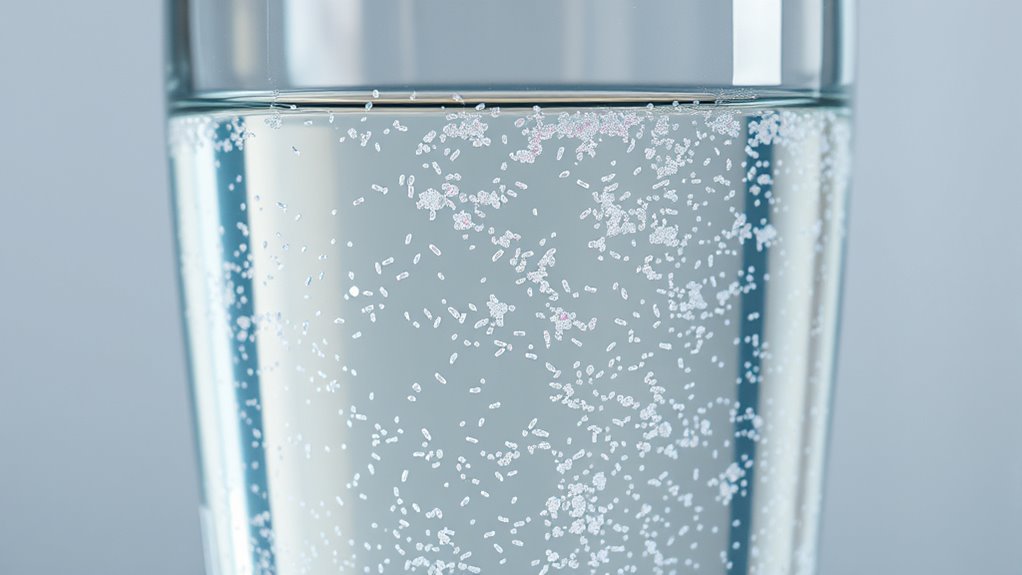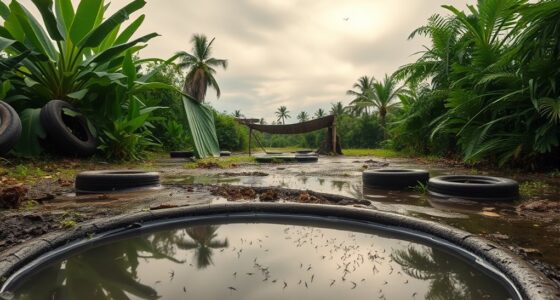Microplastics in your drinking water come from degraded plastics, runoff, and household plumbing, and they can enter water systems through aging pipes and wastewater. These tiny particles can be ingested and may accumulate in your body, raising potential health concerns, although research is still ongoing. While advanced filters can reduce their presence, standards vary globally. To grasp the full picture and learn how to minimize your risk, keep exploring this important topic.
Key Takeaways
- Microplastics can be ingested through drinking water, potentially leading to accumulation in human tissues.
- Size and chemical composition influence microplastics’ ability to penetrate biological barriers and cause health effects.
- Chronic exposure to microplastics may pose risks of inflammation, toxicity, and transfer of embedded harmful substances.
- Current detection methods are improving, but regulatory standards for safe microplastic levels in drinking water are inconsistent.
- Reducing microplastic ingestion involves advanced water treatment, regular monitoring, and public awareness of contamination sources.
Understanding Microplastics: What Are They?

Microplastics are tiny plastic particles less than five millimeters in size. They’re made from various polymer compositions, including polyethylene, polypropylene, and polystyrene, which influence their durability and environmental impact. These particles originate from the breakdown of larger plastic items or from microbeads used in personal care products. Because of their small size, microplastics can easily disperse in water, making them a concern for water quality. Their environmental impact is significant—they persist in ecosystems, ingested by aquatic life, and can eventually enter the human water supply. Understanding their composition helps you recognize how these plastics degrade slowly, persist in the environment, and pose risks to health and ecosystems. Microplastics are more than just tiny particles; they’re a global pollution issue. Additionally, their longevity in the environment means they can accumulate over time, increasing exposure risks for both wildlife and humans.
Sources and Pathways of Microplastics in Water Supplies
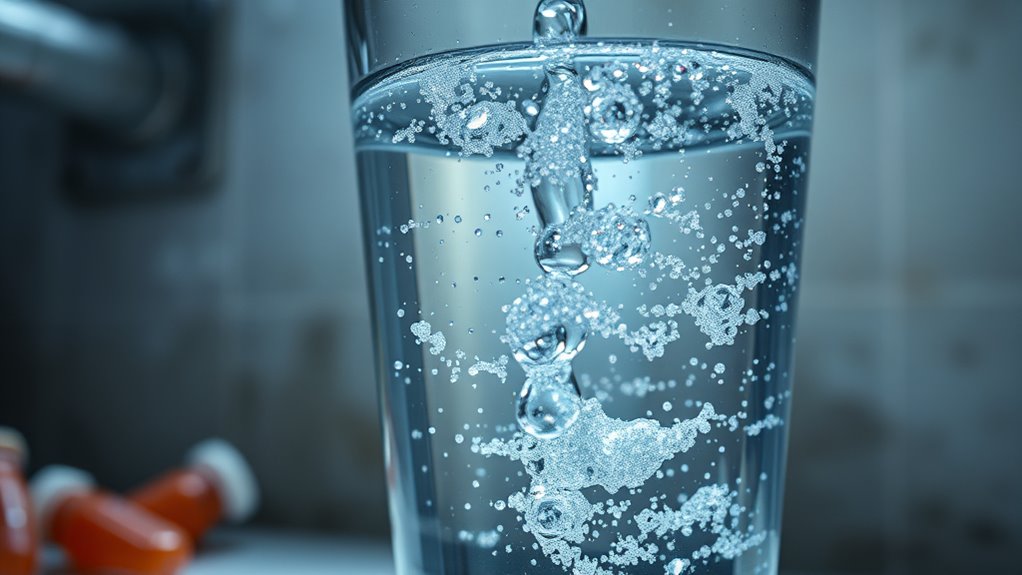
Several human activities introduce microplastics into water supplies through multiple pathways. Industrial runoff is a major source, as manufacturing processes and waste disposal release tiny plastic particles into nearby water bodies. These particles can then travel downstream, eventually reaching drinking water sources. Atmospheric deposition also plays a significant role; microplastics become airborne through tire wear, textile fibers, and other processes, settling onto land and water surfaces. Rain and wind carry these particles into rivers, lakes, and reservoirs. Additionally, improper waste disposal and sewage discharge contribute to the presence of microplastics in water supplies. Understanding these pathways helps you recognize how microplastics enter your drinking water system, emphasizing the importance of monitoring and controlling pollution sources to reduce health risks.
How Microplastics Enter Drinking Water Systems
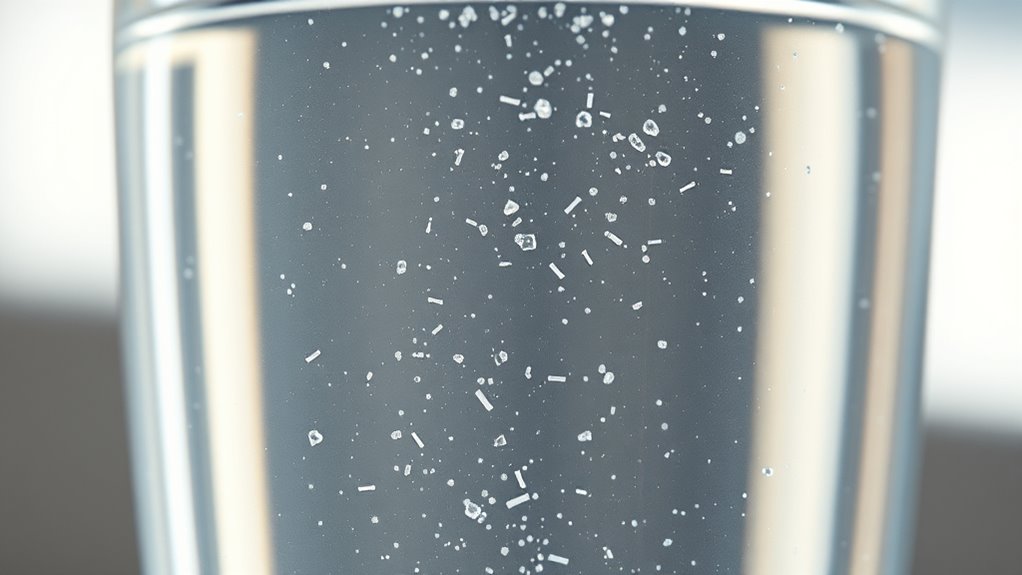
Understanding how microplastics reach your drinking water involves examining the specific pathways they take from their sources to your tap. One key route is pipeline contamination, where microplastics can enter aging or degraded pipelines, especially in older infrastructure. These tiny particles may originate from breakdowns of plastic pipes or fittings, releasing microplastics directly into the water flow. Additionally, household plumbing can be a source; plastic pipes and fixtures can shed microplastics over time, especially with wear and corrosion. Once inside the plumbing system, microplastics can travel with the water to your faucet. The presence of microplastics in water systems is often exacerbated by infrastructure deterioration, which facilitates the release of particles into the water. This process underscores how microplastics are not only present in source waters but can also be introduced during water transport and distribution, making their way into your drinking water supply. Moreover, environmental factors such as rainfall and runoff can wash microplastics from land into water bodies, further contributing to the contamination in supply systems. In some cases, microplastics may also originate from industrial discharges, which can introduce particles directly into water sources before distribution. Furthermore, wastewater treatment plants may not fully filter out microplastics, allowing them to enter natural water bodies and subsequent supply networks.
Methods for Detecting Microplastics in Water
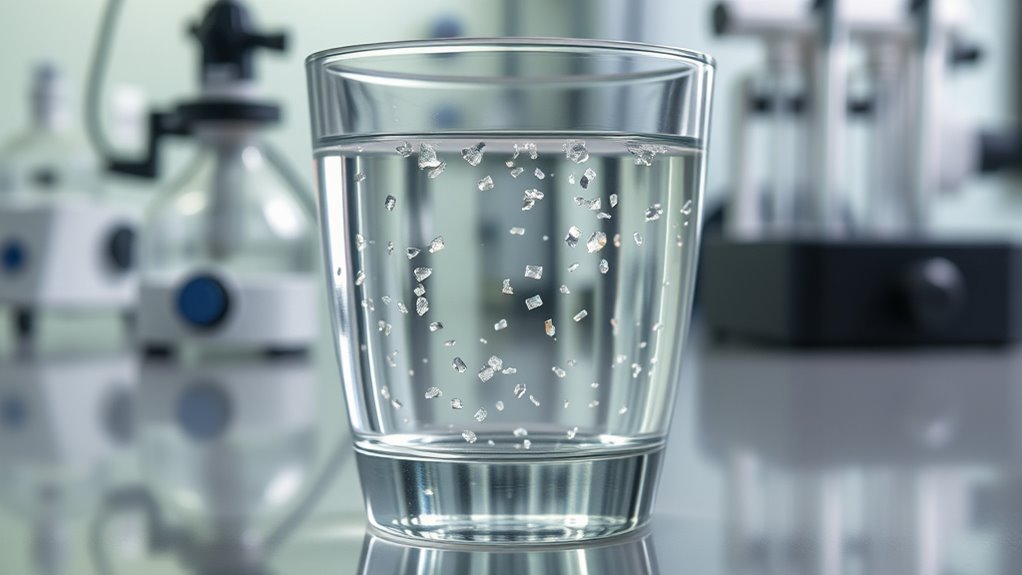
Detecting microplastics in water requires specialized methods that can identify tiny particles accurately. Advanced detection techniques, such as Fourier-transform infrared (FTIR) spectroscopy and Raman spectroscopy, allow you to analyze water samples at a microscopic level. These methods help distinguish microplastics from other particles by identifying their unique chemical signatures. Effective sampling techniques are essential for collecting representative water samples; these include filtering large volumes of water through fine membranes or using specialized pumps. Ensuring proper sample handling prevents contamination and preserves microplastic integrity. Combining robust sampling with advanced detection methods enables you to detect even low concentrations of microplastics. This precision is crucial for evaluating contamination levels and understanding potential health impacts. Additionally, understanding the data privacy challenges associated with analyzing sensitive environmental data is increasingly important in research contexts. Proper sampling protocols are vital to avoid false negatives and ensure the reliability of your results, especially given the importance of accurate detection in assessing environmental health risks. Employing standardized analytical procedures enhances comparability across studies and supports regulatory decision-making.
Potential Human Exposure and Consumption Levels
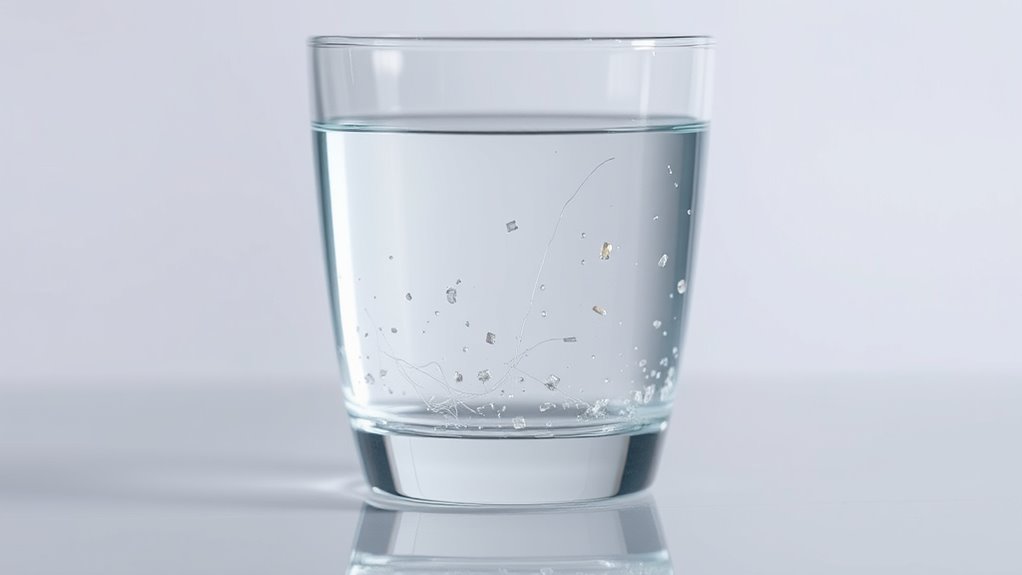
Have you ever wondered how much microplastics you might be ingesting through your drinking water? Your daily exposure varies based on several factors:
- The type of water source you use, like tap or bottled water
- Local water treatment processes that filter microplastics
- Geographic location affecting microplastic contamination levels
- Consumption habits, such as the amount of water you drink daily
- Microplastic contamination levels in your region’s water supply
- The efficacy of water filtration systems in reducing microplastic presence can significantly influence your exposure levels.
- Additionally, regulations and standards for microplastic levels in drinking water vary by region and can impact contamination levels.
- Improving awareness of microplastic contamination can help consumers make informed choices about their water sources.
- Advances in water treatment technology continue to develop methods for more effectively removing microplastics from drinking water, reducing health risks.
Current Research on Health Risks Associated With Microplastics
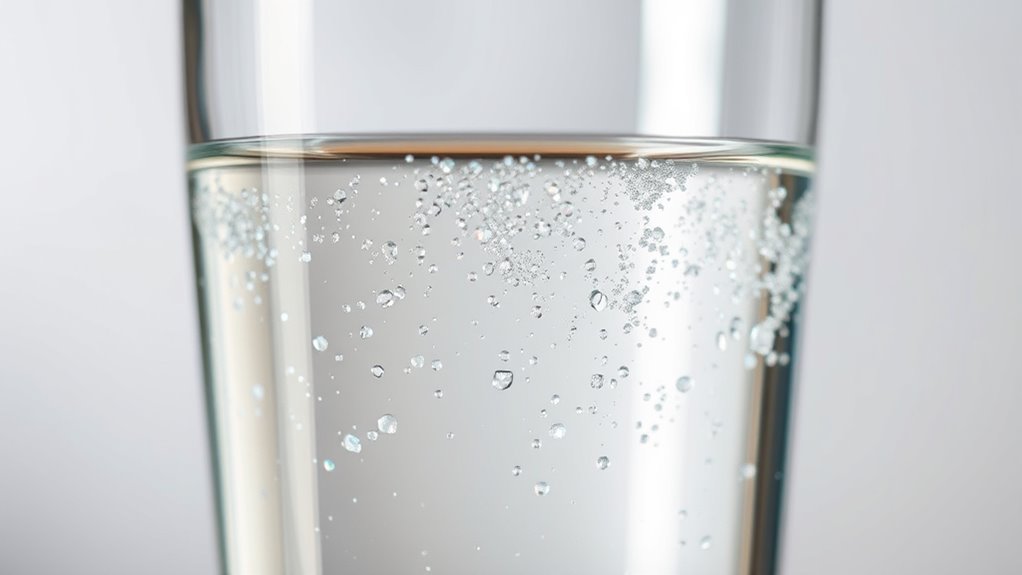
Recent research efforts focus on uncovering the health risks linked to microplastics in drinking water. Scientists are investigating potential long-term effects, such as inflammation, cellular damage, and possible links to chronic diseases. While the full impact remains unclear, evidence suggests vulnerable populations—like children, pregnant women, and the elderly—may face higher risks due to their developing or weakened health. Studies are examining how microplastics may cause physical harm or carry toxic chemicals into the body, potentially disrupting biological functions over time. Additionally, the persistence of microplastics raises concerns about their accumulation in human tissues and the environment. The bioaccumulation process could lead to higher concentrations of harmful substances within the body over prolonged exposure. Emerging research indicates that the size of microplastics can influence their ability to penetrate biological barriers, potentially increasing health risks. As research progresses, it becomes clearer that even low-level, chronic exposure could have cumulative health effects. Understanding the decoding of slang can help contextualize how informal language evolves alongside scientific discussions, making information more accessible. Staying informed about ongoing findings helps you understand the importance of addressing microplastic contamination in your drinking water.
Regulatory Standards and Water Treatment Strategies
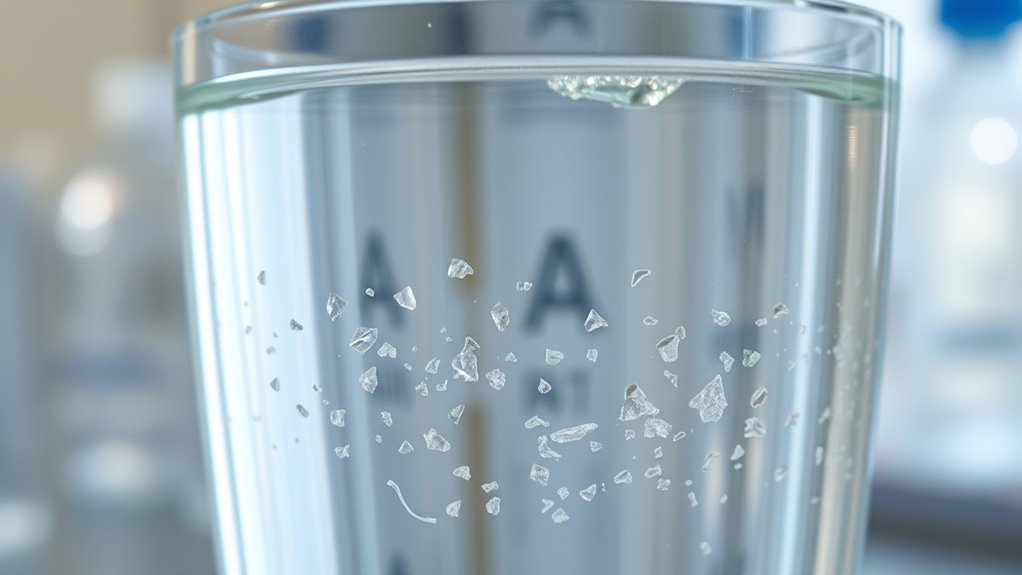
Regulatory standards and water treatment strategies play a crucial role in minimizing microplastic contamination in drinking water. Despite growing awareness, policy gaps remain, and international standards are inconsistent across regions. To address this, you can focus on implementing advanced filtration methods, such as membrane filtration and activated carbon. Regular monitoring and testing help identify contamination sources. Public policies should promote stricter limits on microplastics, aligning with emerging scientific evidence. Collaboration between governments and water treatment facilities is essential to develop effective strategies. Additionally, investing in research on innovative removal techniques ensures future safety. Understanding cookie management and user consent options can also enhance transparency and public trust in water safety initiatives. By closing policy gaps and adopting robust treatment strategies, you help protect public health and ensure access to clean, microplastic-free drinking water.
Steps to Reduce Microplastic Intake From Drinking Water
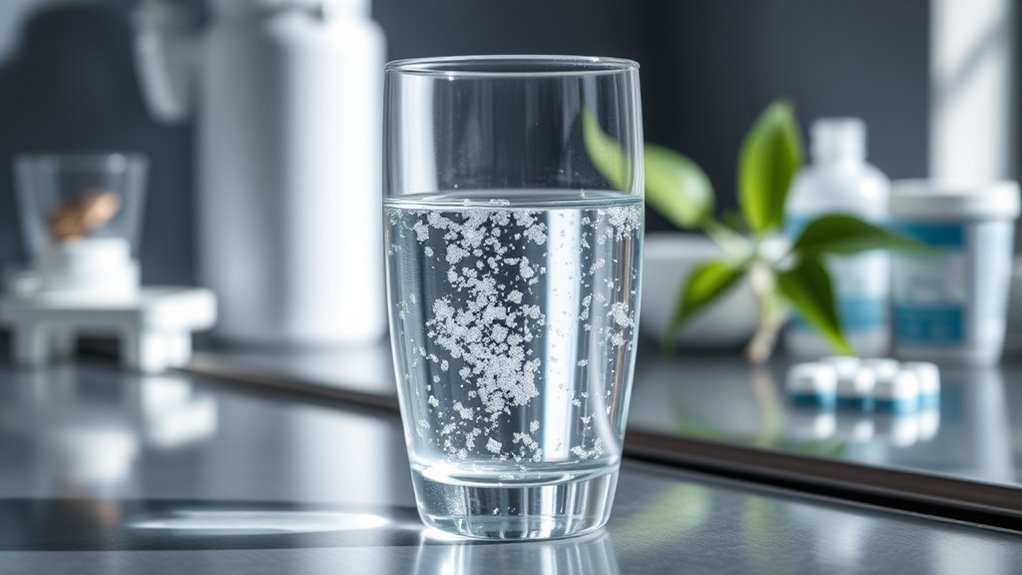
To effectively reduce your microplastic intake from drinking water, start by choosing sources known for higher quality and stricter filtration standards. Installing household filtration systems, such as activated carbon or reverse osmosis filters, can markedly lower microplastic levels in your tap water. Regularly maintaining and replacing filters ensures ideal performance. Additionally, stay informed about public awareness initiatives that highlight microplastic contamination and safe water practices. Supporting local efforts to improve water quality can lead to broader improvements in public health. Be mindful of bottled water, which may contain microplastics; opting for filtered tap water is often safer. Using advanced filtration technologies can further enhance the removal of microplastics from your water. Moreover, understanding the latest breakthroughs in machine learning tech can assist in developing smarter water purification systems that adapt to contamination levels. Paying attention to microplastic detection methods can also help consumers and authorities identify and address contamination more effectively. Engaging with public health research can provide valuable insights into emerging risks and mitigation strategies.
Frequently Asked Questions
How Do Microplastics Affect Vulnerable Populations Differently?
You might wonder how microplastics impact vulnerable populations differently. Socioeconomic disparities often mean limited access to clean water, increasing exposure for low-income groups. Developmental vulnerabilities make children and pregnant women more susceptible to health issues from microplastics. Because these groups already face health challenges, microplastics can exacerbate their risks, leading to long-term developmental and health problems. Addressing these disparities is key to protecting everyone’s health.
Are There Specific Microplastics Linked to Health Conditions?
You might wonder if certain microplastic types are linked to health conditions. Research shows some microplastics, like polyethylene and polypropylene, have potential health correlations, especially when ingested over time. These particles can carry toxic chemicals or pathogens, increasing health risks. While definitive links are still being studied, understanding the specific types of microplastics in your water can help assess potential health impacts, especially for vulnerable groups.
Can Microplastics Transfer Toxic Chemicals in the Body?
Imagine microplastics as tiny sponges, soaking up toxic chemicals as they travel through your body. Yes, they can transfer harmful chemicals through chemical transfer and bioaccumulation processes, potentially harming your health over time. These particles can carry contaminants deeper into tissues, increasing risks of inflammation or other issues. You can’t see this silent invasion, but it underscores the importance of understanding how microplastics impact your well-being.
How Effective Are Household Water Filters Against Microplastics?
You might wonder how effective household water filters are against microplastic removal. Filter efficiency varies depending on the type of filter you use; some are designed to trap very small particles, including microplastics. Activated carbon and reverse osmosis filters tend to be more effective at removing microplastics, while basic pitcher filters may not. To guarantee the best protection, choose a filter specifically rated for microplastic removal.
What Future Research Is Needed to Clarify Health Risks?
They say, “knowledge is power,” and future research should focus on understanding health risks by developing standardized testing methods for microplastics, ensuring consistent water quality assessments. You need studies that determine safe exposure levels and long-term effects. This research will help regulators and consumers make informed decisions, reducing potential health hazards. As water quality concerns grow, identifying clear risks becomes essential for safeguarding public health.
Conclusion
To protect your health, stay informed, stay vigilant, and stay proactive. Understand the sources of microplastics, recognize the risks they pose, and support efforts to improve water quality. Advocate for stronger regulations, choose water treatment options wisely, and reduce plastic use in your daily life. By taking these steps, you can minimize your exposure, contribute to environmental preservation, and promote safer drinking water for yourself and future generations.
